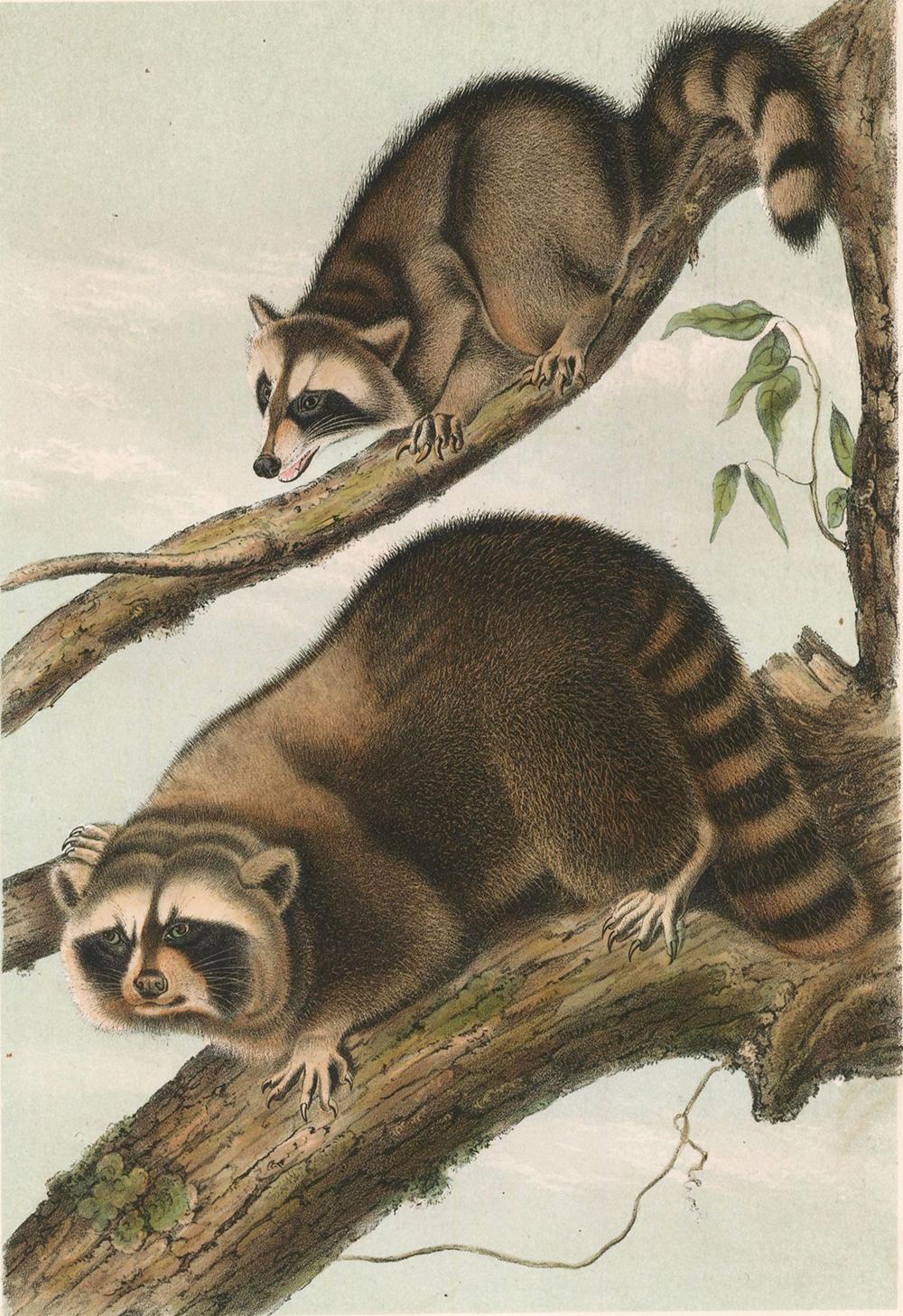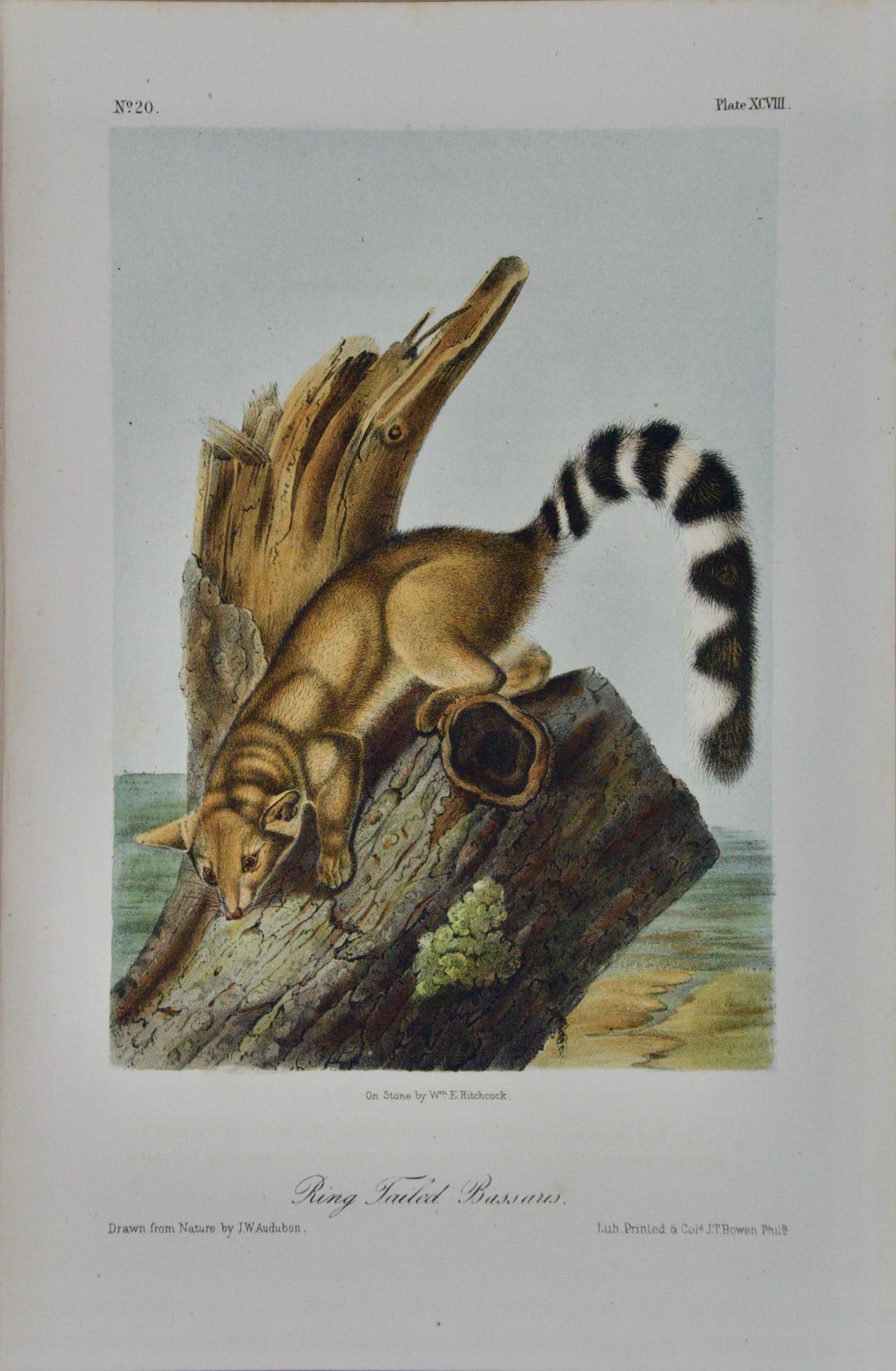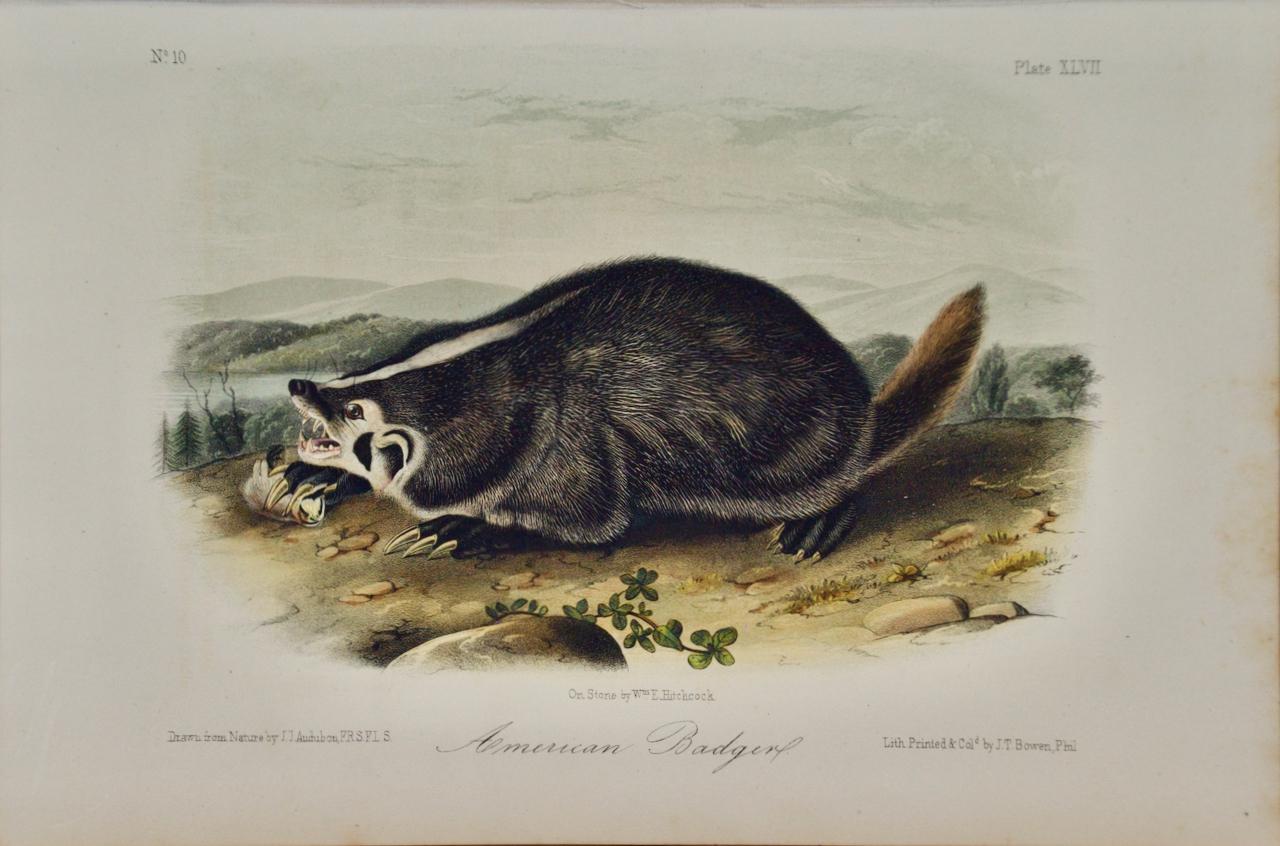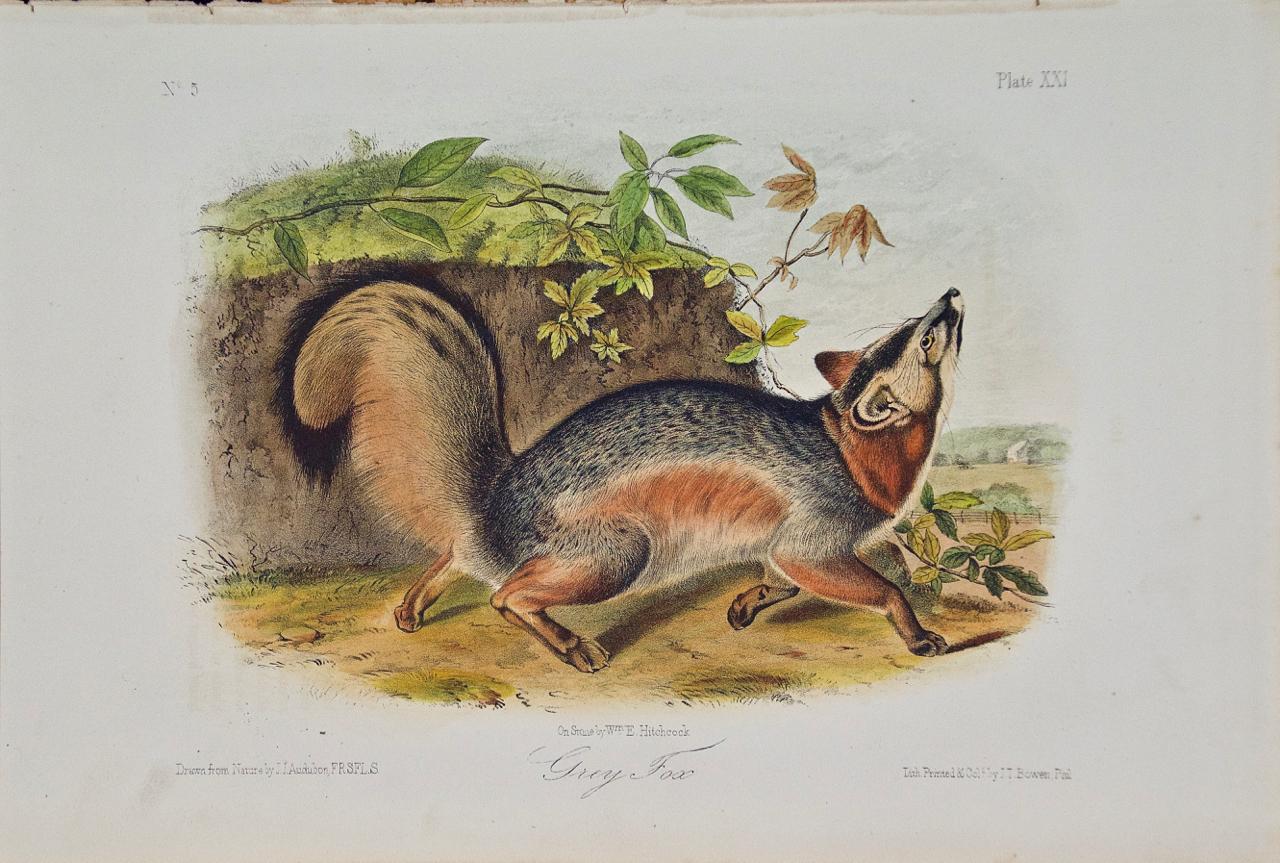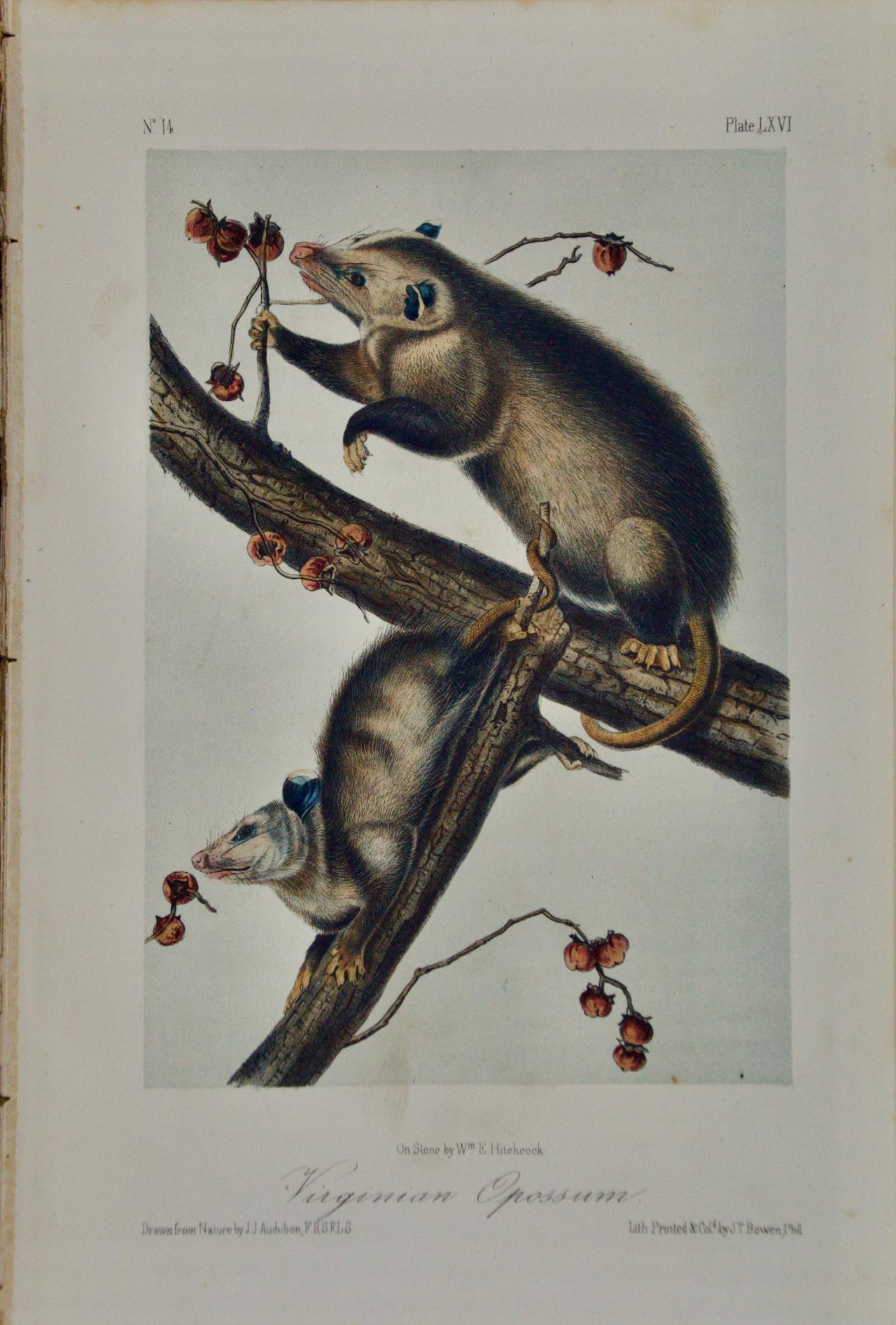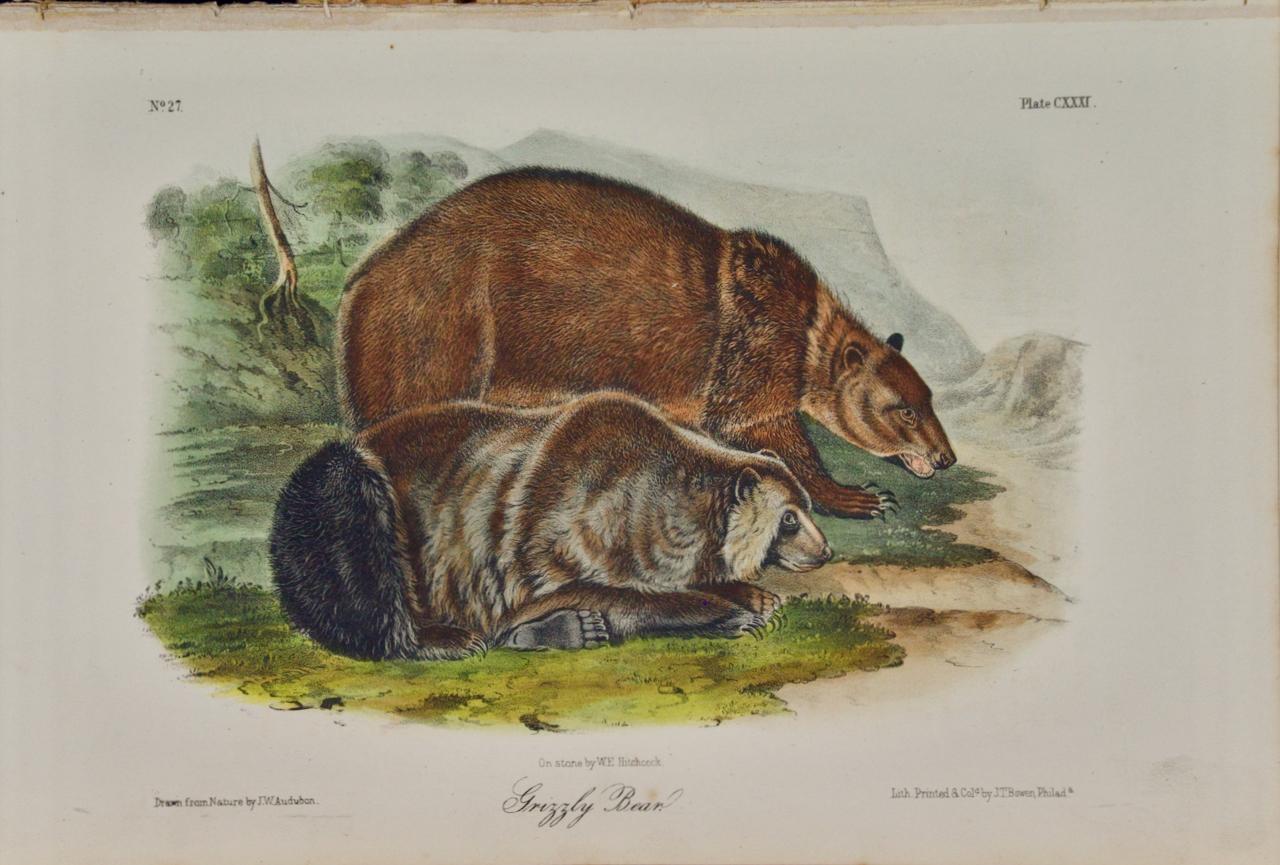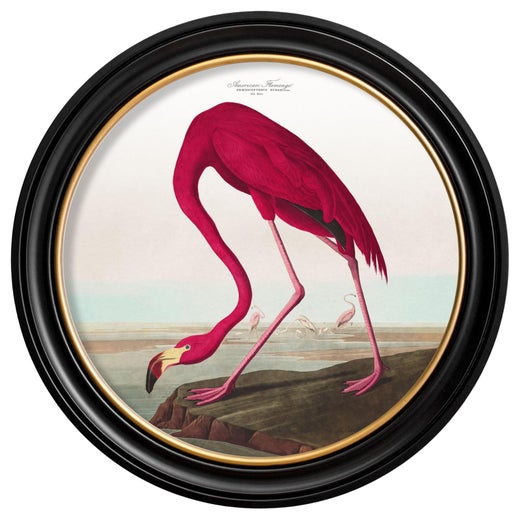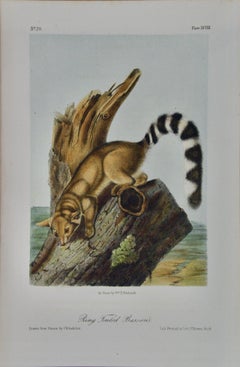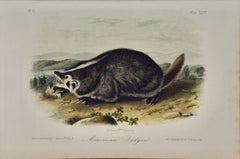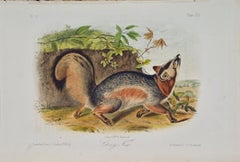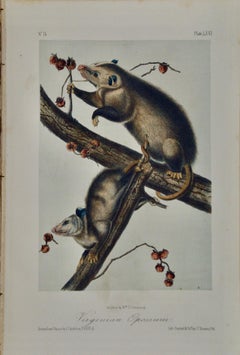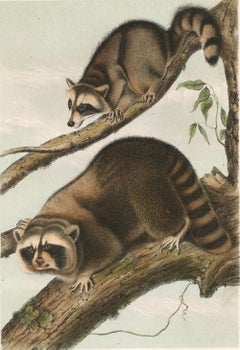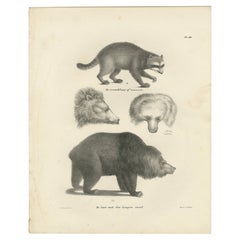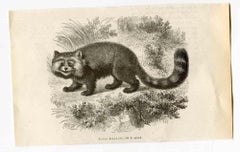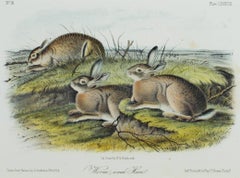Items Similar to Raccoon: An Original 19th Century Audubon Hand-colored Lithograph
Want more images or videos?
Request additional images or videos from the seller
1 of 6
John James AudubonRaccoon: An Original 19th Century Audubon Hand-colored Lithograph1849-1854
1849-1854
$775
£590.78
€674.92
CA$1,090.53
A$1,194.47
CHF 628.89
MX$14,255.64
NOK 8,014.64
SEK 7,326.59
DKK 5,043.47
About the Item
This is an original 19th century John James Audubon hand colored lithograph entitled "Raccoon", No. 13, Plate LXI, 61, from Audubon's "Quadrupeds of North America", printed and colored by J.T. Bowen and published in Philadelphia from 1849-1854. It depicts two raccoons, presumably a male and a female, on branches of a tree, looking to the left.
This antique hand-colored Audubon quadruped lithograph has a tiny spot in the upper margin on the left and a tiny faint spot in the left margin, but it is otherwise in excellent condition. The sheet measures 10.5" high and 7" wide. The descriptive text pages, 75-82, from Audubon's original publication are included.
John James Audubon (1785-1851) was a naturalist and artist. He was initially unsuccessful financially prior to the publication of his famous work “The Birds of America”, spending time in debtor’s prison, once stabbing a disgruntled investor in self-defense. However, his obsession with birds and art motivated him to persist in his goal of documenting every bird in America via his watercolor paintings and publishing his works for all to enjoy. Audubon's first illustrations were published in a large elephant folio size. Due to their expense they were purchased in rather small numbers by the wealthy. To reach a larger audience, Audubon, with the help of his sons and J. T. Bowen, published a smaller octavo sized lithograph version, which were much more affordable.
With the success of his bird projects, Audubon then turned his attention to four-legged animals. He explored the Missouri River in 1843 sketching the four-legged animals he encountered in their natural setting. His expedition covered some of the same regions recently explored by Lewis and Clark, traveling from present day Alaska to Mexico. Audubon realized that this was an opportunity to document these animals in the still relatively pristine American wilderness, before man encroached on their environment.
Between 1845 and 1848, Audubon and his sons John Woodhouse Audubon and Victor Gifford Audubon produced a set of elephant folio sized lithographs that were primarily engraved and hand colored by J. T. Bowen in Philadelphia. The publication, which included text descriptions of the animals was published 3 years before Audubon died. As with the birds, this was followed by a three-volume set of 155 octavo-sized plates entitled “The Quadrupeds of North America” completed and published by Audubon’s sons, John, Jr. and Victor.
Audubon prints continue to be popular and a wise investment. The double elephant folio set “The Birds of America” have sold at auction for as much as $8.8 million, and individual plates may sell for six figures. The beautiful, but less well-known quadruped plates are not as expensive, but becoming more sought after, as the birds become unattainable to all but the very wealthy.
- Creator:John James Audubon (1785-1851, American, French)
- Creation Year:1849-1854
- Dimensions:Height: 10.5 in (26.67 cm)Width: 7 in (17.78 cm)
- Medium:
- Movement & Style:
- Period:
- Framing:Framing Options Available
- Condition:
- Gallery Location:Alamo, CA
- Reference Number:Seller: # 18291stDibs: LU1173210623122
John James Audubon
John James Audubon (April 26, 1785, Les Cayes, Saint-Domingue (later Haiti) – January 27, 1851 (aged 65) Manhattan, New York, U.S.), born Jean-Jacques Audubon, was an American ornithologist, naturalist, and painter. He was notable for his expansive studies to document all types of American birds and for his detailed illustrations that depicted the birds in their natural habitats. His major work, a color-plate book entitled The Birds of America (1827–1839), is considered one of the finest ornithological works ever completed. Audubon identified 25 new species.
About the Seller
5.0
Platinum Seller
Premium sellers with a 4.7+ rating and 24-hour response times
Established in 2011
1stDibs seller since 2019
299 sales on 1stDibs
Typical response time: 1 hour
- ShippingRetrieving quote...Shipping from: Alamo, CA
- Return Policy
More From This Seller
View AllRing-Tailed Bassaris: An Original Audubon Hand-colored Lithograph
By John James Audubon
Located in Alamo, CA
This is an original John James Audubon hand colored lithograph entitled "Ring-Tailed Bassaris", No. 20, Plate XCVIII, 98, from John James Audubon's Qu...
Category
Mid-19th Century Naturalistic Animal Prints
Materials
Lithograph
American Badger: An Original 19th Century Audubon Hand-colored Lithograph
By John James Audubon
Located in Alamo, CA
This is an original 19th century John James Audubon hand colored lithograph entitled "American Badger", No. 10, Plate XLVII, 47, from Audubon's "Quadrupeds of North America", printed...
Category
Mid-19th Century Naturalistic Animal Prints
Materials
Lithograph
Grey Fox: An Original 19th Century Hand-colored Lithograph by Audubon
By John James Audubon
Located in Alamo, CA
This is an original John James Audubon hand-colored lithograph entitled "Grey Fox, No. 5, Plate XXI" from John James Audubon's Quadrupeds of North America, published in Philadelphia ...
Category
Mid-19th Century Naturalistic Animal Prints
Materials
Lithograph
Virginian Opossum: An Original Audubon Hand-colored Lithograph
By John James Audubon
Located in Alamo, CA
This is an original John James Audubon hand-colored lithograph entitled "Virginian Opossum", No. 14, Plate LXVI, 66, from John James Audubon's Quadrupeds of North America, drawn on s...
Category
Mid-19th Century Naturalistic Animal Prints
Materials
Lithograph
"Grizzly Bear", an Original 19th C. Audubon Hand Colored Quadruped Lithograph
By John James Audubon
Located in Alamo, CA
This is an original John James Audubon hand-colored royal octavo lithograph entitled "Grizzly Bear", No. 27, Plate CXXXI from Audubon's "Quadrupeds of North America". It was drawn on...
Category
Mid-19th Century Naturalistic Animal Prints
Materials
Lithograph
Jackall Fox: An Original 19th C. Hand-colored Lithograph by John J. Audubon
By John James Audubon
Located in Alamo, CA
This is an original 19th century John James Audubon hand colored lithograph entitled "Jackall Fox", No. 31, Plate CLI, 151, from Audubon's "Quadrupeds of North America", printed and ...
Category
Mid-19th Century Naturalistic Animal Prints
Materials
Lithograph
You May Also Like
Raccoon by Audubon
By John James Audubon
Located in New York, NY
Original stone lithograph with hand-coloring from "The Quadrupeds of North America. Octavo Edition" by John James Audubon. Plate LXI. Phil...
Category
1850s Animal Prints
Materials
Paper
19th-Century Lithograph of a Raccoon and Bear – Stunning Natural History Print
Located in Langweer, NL
19th-Century Lithograph of a Raccoon and Bear – Stunning Natural History Print
This finely executed 19th-century lithograph presents a striking depiction of a raccoon (De waschbee...
Category
Antique 1830s Prints
Materials
Paper
Red Panda - Lithograph by Paul Gervais - 1854
By Paul Gervais
Located in Roma, IT
Red Panda is an original lithograph on ivory-colored paper, realized by Paul Gervais (1816-1879). The artwork is from The Series of "Les Trois Règnes de la N...
Category
1850s Modern Animal Prints
Materials
Paper, Lithograph
19th century color lithograph hare landscape grass animal print wildlife
By John James Audubon
Located in Milwaukee, WI
"Worm-Wood Hare" is an original color lithograph by John James Audubon. It depicts three brown rabbits in a landscape. No. 18, Plate LXXXVIII, On Stone by W.E. Hitchcock.
6" x 8" ar...
Category
1840s Other Art Style Animal Prints
Materials
Lithograph
19th century color lithograph hares animal nature print wildlife
By John James Audubon
Located in Milwaukee, WI
"Townsend's Rocky Mountain Hare" is an original color lithograph by John James Audubon. This artwork features two gray hares in a muted, cool-colored landscape.
5 1/2" x 8 1/4" art...
Category
Mid-19th Century Academic Animal Prints
Materials
Lithograph
19th century color lithograph hare animal print wildlife
By John James Audubon
Located in Milwaukee, WI
"Northern Hare" is an original color lithograph by John James Audubon. This piece depicts a white rabbit in a cool green landscape.
5 3/4" x 7 3/4" art...
Category
1840s Other Art Style Animal Prints
Materials
Lithograph
